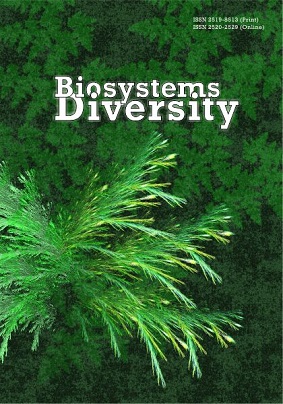Розподіл вмісту важких металів у системі «вода – донні відкладення» транскордонної річки Уж
The distribution of heavy metals content in the bottom deposits of the trans-border Uzh river system
Author(s): N. I. Nikolaichuk, M. V. BilkeySubject(s): Human Ecology, Sociobiology
Published by: Дніпропетровський національний університет імені Олеся Гончара
Keywords: anthropogenic pressure; bottom deposits; hydro-ecosystem; threshold limit value;
Summary/Abstract: The dynamics and peculiarities of the heavy metals (Cu, Pb, Zn, As, V, Cr, Ni) migration were established in the system of the river Uzh bottom deposits. An excess in maximum permissible concentration among such elements as Zn, V, As, and Cu was detected in surface waters. We may connect the elevated level of Cu and Zn with natural (metals appearing in ground water run-off, ablation from iron ore, the reaction of interstitial water), anthropogenic (sewage disposals from communal households and manufacturing plants, agricultural run-offs), and hydrochemical (pH of water medium, methylation of non-organic metal compounds, metals release from the organic compounds composition, ingress from bottom deposits) factors. The high concentrations of vanadium in the water as well as in bottom deposits are most probably induced by the leaching of elements from the regional volcanic rocks. The plumbum content did not exceed the higher-than-normal rates; however, significant element accumulation was detected in bottom deposits outside the city of Uzhgorod which may be the result of ecotoxicant ingress along with land runoff from the riverside highways laid parallel to the water course. In comparison with background measures, the highest chromium and nickel concentrations were detected near the streamlet Domoradzh and, therefore, it is assumed that the industrial wastewaters serve here as a source of heavy metals. The reservoir in the lowland is above all enriched by arsenic. Areas under agricultural use are significantly concentrated in lowlands. Runoffs from these areas are the main source of the ore supply. However, the impact of municipal domestic waste water which contains arsenic-containing detergents should not be excluded. Moreover, we found a relationship between the relief heterogeneity of the study area and distribution of heavy metals in the hydro-ecosystem. The accomplished comparative analysis of the territories under study indicates the significant pollution level of the surface waters in technologically transformed areas, whereas the largest accumulation of pollutants is concentrated in bottom deposits of the river, which indicates a constant supply of pollutants to the streamflow.
Journal: Biosystems Diversity
- Issue Year: 25/2017
- Issue No: 2
- Page Range: 145-153
- Page Count: 9
- Language: Ukrainian

